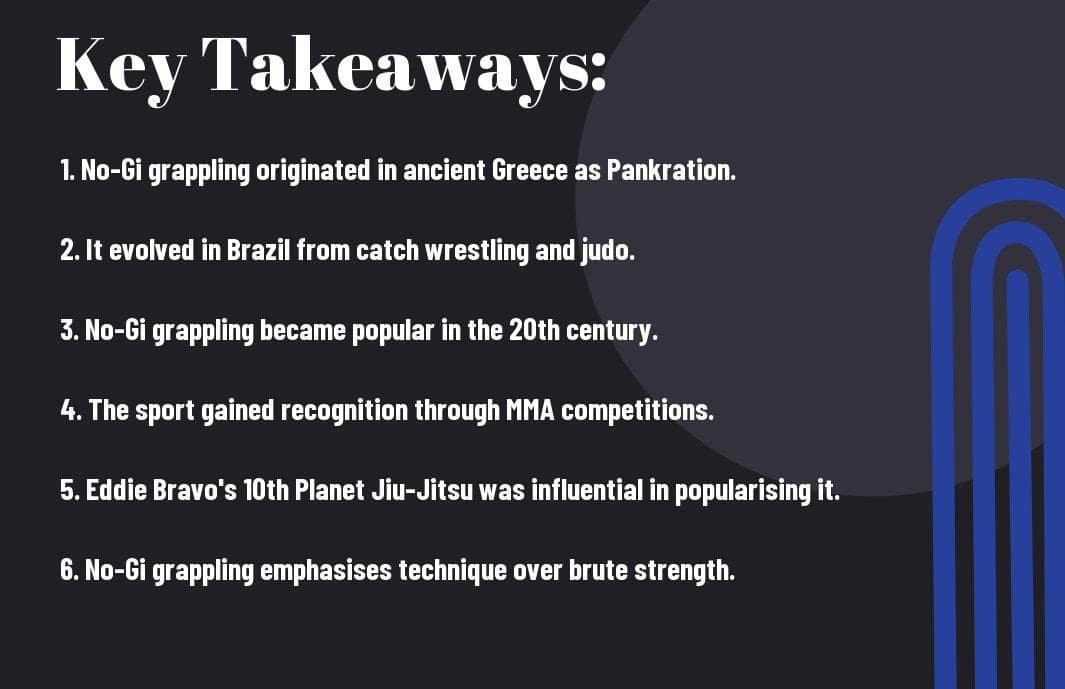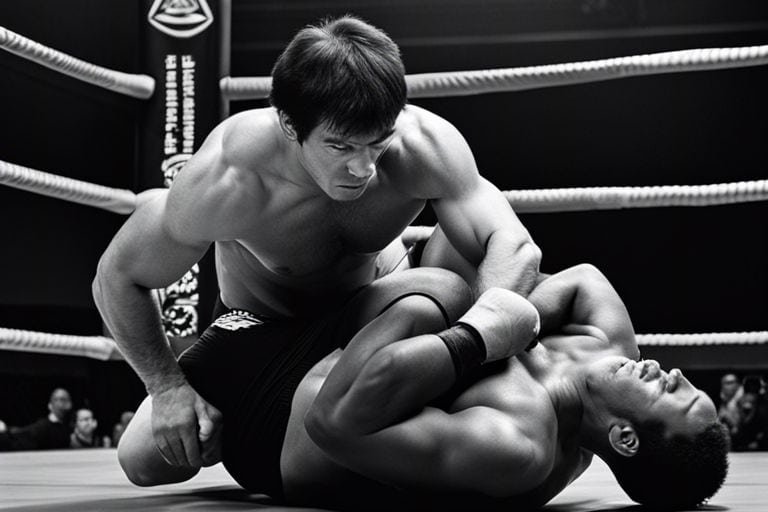Have you ever wondered about the origins and history of no-gi grappling? In this informative blog post, we will delve into the evolution of this highly effective martial art form. From its roots in ancient combat systems to its rise in modern mixed martial arts, you will gain a comprehensive understanding of how no-gi grappling has become an integral part of the martial arts world.
Key Takeaways:
- No-Gi grappling originated from ancient martial arts disciplines and has evolved over time to become a popular sport and self-defense technique.
- The history of No-Gi grappling can be traced back to various ancient combat forms including wrestling, judo, and Brazilian Jiu-Jitsu.
- Modern-day No-Gi grappling has gained widespread popularity through events such as submission grappling tournaments, MMA competitions, and the development of specific grappling styles and techniques.
- Key figures in the history of No-Gi grappling include martial arts pioneers such as Helio Gracie, Eddie Bravo, and various submission grappling champions who have contributed to the growth and evolution of the sport.
- Today, No-Gi grappling continues to be a dynamic and evolving discipline, with a dedicated community of practitioners and a growing presence in the mainstream sports arena.

Pre-Modern Origins of No-Gi Grappling
Before the advent of modern sports and martial arts, no-gi grappling had its roots in various ancient wrestling practices. These early forms of grappling often took place in different cultures and societies, each with its own unique traditions and techniques.
Ancient Wrestling Practices Across Cultures
Ancient wrestling was a common form of combat across various cultures, including Ancient Greece, Egypt, China, and Japan. In Ancient Greece, wrestling was a revered sport and an integral part of the Olympic Games. The Egyptians also depicted wrestling in hieroglyphs, emphasizing its importance in their society. Meanwhile, Chinese martial arts such as Shuai Jiao and Japanese martial arts like Jujutsu incorporated grappling techniques as part of their combat systems. These early forms of grappling laid the groundwork for the development of no-gi techniques that we see today.
Transition from Traditional Attire to No-Gi
Historically, many traditional wrestling practices involved competitors wearing specific attire, such as loincloths or robes, which were often used as grips during the matches. As these ancient practices evolved into modern sports and martial arts, the transition from traditional attire to no-gi grappling became increasingly prevalent. The development of no-gi grappling allowed practitioners to focus on technique and leverage rather than relying on the gripping and cloth-based techniques prevalent in traditional attire. This shift in attire brought about a new set of challenges and opportunities, ultimately contributing to the evolution of no-gi grappling as a distinct discipline.
By understanding the ancient wrestling practices across various cultures and the transition from traditional attire to no-gi grappling, you gain a deeper appreciation for the rich history and evolution of no-gi grappling as a formidable form of combat and competitive sport. The early influences and adaptations highlight the importance of technique and leverage in no-gi grappling, ultimately emphasising the essential role these elements play in mastering this dynamic martial art.
Development in the 20th Century
You may be wondering how no-gi grappling has evolved over time. Well, the 20th century saw significant developments in the sport, shaping it into what it is today. If you want to delve deeper into the history and modern techniques of no-gi jiu-jitsu, you can check out this No Gi Jiu Jitsu: An In-Depth Guide To Modern BJJ resource.
Judo and Brazilian Jiu-Jitsu Influence
During the 20th century, the emergence of no-gi grappling was heavily influenced by Judo and Brazilian Jiu-Jitsu. These martial arts emphasise the importance of leveraging your opponent’s strength and utilising technique and leverage to overcome them. This influence played a crucial role in the development of no-gi grappling as it is known today.
Emergence of Submission Wrestling
Another significant development in the 20th century was the emergence of submission wrestling. This style of wrestling prioritises grappling and submission holds, with a strong focus on ground fighting. The emphasis on submitting your opponent rather than simply pinning them down became a defining feature of no-gi grappling, and it continues to be a fundamental aspect of the sport today.
No-Gi Grappling in Combat Sports
As no-gi grappling gained popularity, it began to be incorporated into various combat sports. No-gi grappling is a fundamental aspect of mixed martial arts (MMA), where fighters utilize a combination of wrestling, Brazilian Jiu-Jitsu, and other grappling techniques to control and submit their opponents without the use of a traditional gi. The absence of a gi allows for a faster paced and more dynamic style of grappling, making it an essential skill for MMA competitors.
No-Gi Competitions and Rule Sets
No-gi grappling competitions have their own unique rule sets that differ from traditional gi grappling. Without the gi to grip onto, competitors must rely more on body control, strength, and agility. Many no-gi tournaments allow for a wider variety of leg locks and other submission techniques, making for a more unpredictable and exciting competition. This has led to the development of specific rule sets focused on no-gi grappling, catering to the unique dynamics of the sport.
Prominent No-Gi Grapplers and Their Impact
Several prominent no-gi grapplers have made a significant impact on the sport and its evolution. Talented athletes such as Eddie Bravo, Marcelo Garcia, and Garry Tonon have pioneered new techniques and approaches, pushing the boundaries of what is possible in no-gi grappling. Their innovative styles and contributions have inspired a new generation of grapplers, shaping the landscape of the sport and opening up new possibilities for those who train and compete in no-gi grappling.
No-Gi Grappling Today
Nowadays, no-gi grappling has become a significant aspect of the wider grappling world. It is not uncommon to see no-gi divisions in grappling tournaments and events, and there is a growing number of gyms dedicated to no-gi training. This style has gained popularity thanks to its dynamic and fast-paced nature, as well as its practical applications in self-defence and mixed martial arts (MMA).
The Rise of No-Gi Training and Gyms
In recent years, the rise of no-gi grappling has led to the establishment of numerous gyms and training facilities specifically focused on this style. These gyms often attract individuals who are seeking a more dynamic and versatile approach to grappling, as well as those interested in honing their skills for MMA competition. As a result, no-gi training has become a prominent feature of the modern grappling landscape, providing practitioners with an alternative and effective way to improve their grappling abilities.
The Future and Evolution of No-Gi Grappling
The future of no-gi grappling is an exciting prospect, with the style continuing to evolve and adapt to the ever-changing demands of the grappling community. As more practitioners and athletes embrace the no-gi approach, new techniques and strategies are constantly being developed, pushing the boundaries of what is achievable in this dynamic style. Furthermore, the increasing integration of no-gi principles into MMA and self-defence training suggests that this style will continue to play a vital role in the grappling world for years to come.
Conclusion
So, now that you have explored the origins and history of no-gi grappling, you have gained a deeper understanding of this discipline’s evolution and development. From its roots in ancient wrestling traditions to its modern emergence as a popular sport and martial art, you can appreciate the rich heritage and diverse influences that have shaped no-gi grappling. As you continue to learn and practice this dynamic form of combat, you can draw inspiration from its fascinating history and cultural significance.
FAQ
Q: What is No-Gi Grappling?
A: No-Gi Grappling is a form of submission wrestling that does not require the competitors to wear traditional martial arts uniforms, known as Gis. It focuses on clinch fighting and ground grappling techniques.
Q: What are the origins of No-Gi Grappling?
A: No-Gi Grappling originated from Brazilian Jiu-Jitsu, but it evolved as a separate discipline with its own set of rules and techniques. It has also been influenced by other grappling arts such as wrestling and judo.
Q: When did No-Gi Grappling first emerge as a distinct sport?
A: No-Gi Grappling began to emerge as a distinct sport in the 1990s, gaining popularity through events such as the Abu Dhabi Combat Club (ADCC) Submission Wrestling World Championship.
Q: What are the key differences between Gi and No-Gi Grappling?
A: The main difference lies in the attire and grip. Gi Grappling involves the use of a traditional uniform, which allows for additional grips and techniques. In No-Gi Grappling, competitors do not have the same grips and must rely more on body positioning and leverage.
Q: How has No-Gi Grappling evolved over the years?
A: No-Gi Grappling has evolved to become a highly technical and dynamic sport, with athletes developing innovative techniques and strategies. It has also gained recognition as a core component of mixed martial arts (MMA).
Q: What are the major organisations and events in No-Gi Grappling?
A: The major organisations include the ADCC, Eddie Bravo Invitational (EBI), and International Brazilian Jiu-Jitsu Federation (IBJJF). Events such as the ADCC World Championship and EBI tournaments showcase top talent in No-Gi Grappling.
Q: How can someone get started in No-Gi Grappling?
A: To get started in No-Gi Grappling, individuals can find a reputable martial arts gym or academy that offers classes specifically focused on No-Gi training. It is important to learn from experienced instructors and gradually build skills and technique through regular practice and training.



